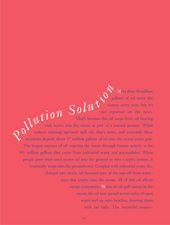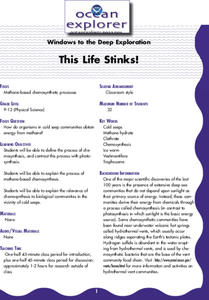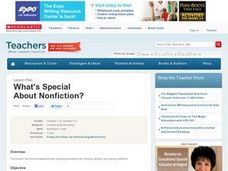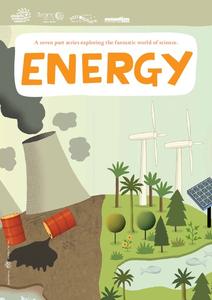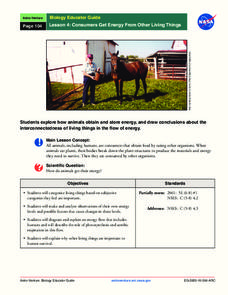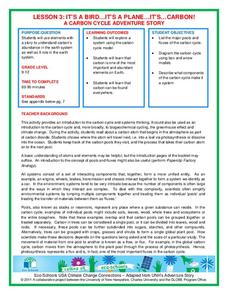Curated OER
A Pre-Treatment Model for Ethanol Production Using a Colorimetric Analysis of Starch Solutions
Learners recognize the benefits of ethanol and study photosynthesis. In this ethanol lesson plan students complete an experiment that shows the procedure that starch can be hydrolyzed by salivary amylase.
Education World
Leaves Change Color Scavenger Hunt
In this leaves changing worksheet, students use the Internet to search a specific website to find the answers to fill in seventeen blanks involving the reasons why leaves change colors during the Fall season.
Curated OER
Life in the Ocean
For this ocean life worksheet, students review the animal and plant plankton and photosynthesis in the ocean. Students fill in the blank of 15 statements and then find these terms in a word search.
Curated OER
Pollution Solution
Fourth graders examine how trees help to absorb the pollution that is emitted from automobiles. They review the process of photosynthesis and determine how forest management is important on their reservation. They think about the...
Curated OER
Redwood Trees: How Does Water Get to the Top of the Tree
Students discuss photosynthesis. They explore and discuss surface tension, hydrogen bonding and capillary action with hands on experiments. They make journal entries and draw pictures of the different stages of the experiments.
Curated OER
This Life Stinks!
Pupils explore the process of chemosynthesis and contrast this process with photosynthesis. They consider the relevance of chemosynthesis to biological communities in the vicinity of cold seeps.
Curated OER
SAV Plants of the St. Mary¿¿¿s River Ecosystem
Students examine the importance of submerged aquatic vegetation in the St. Mary River ecosystem. They identify different characteristics of common eelgrass and discuss water quality, photosynthesis, habitat, oxygen production.
Curated OER
Where Do Green Plants Get Energy?
Fourth graders realize that plants need light, water, and carbon dioxide to carry out photosynthesis. They participate in groups of 4 to plant (with materials provided) a test group of beans to compare to the control group, write a...
Curated OER
Water Quality
In this water worksheet, students determine the factors that effect the solubility of gases, calculate the percent concentration of solutions, and give the balanced chemical equation for photosynthesis. This worksheet has 18 short answer...
Curated OER
Primary Productivity in Headwater (deciduous Dominated) Streams in Winter
Students study outside sources of energy that are associated with the headwater streams in northern Michigan. They study how leaf fall is an important food source for macroinvertebrates and how photosynthesis drives the production of...
Curated OER
Science Revision
In this biology learning exercise, learners identify and locate various vocabulary terms pertaining to photosynthesis and kinetic energy. There are 54 biology terms located in the word search.
Curated OER
Physical and Chemical Changes
Sixth graders complete several experiments about chemical and physical changes. In this physical and chemical science instructional activity, 6th graders complete 6 experiments about chemical and physical changes. Students examine the...
Nuffield Foundation
Measuring the Rate of Metabolism
Plant respiration can be a difficult concept for young biologists to grasp; with a hands-on lab, learners can collect and graph data, then calculate the metabolism rate for the plants they studied. If you do not have a respirometer,...
Curated OER
Protists - The Protozoans
Five pages provide thorough coverage of three protozoans: euglena, amoebae, and paramecia. For each, junior biologists read factual text, label the organism, and write answers to several questions. This neatly organized assignment is...
Forest Foundation
The Nature of Trees
Young botanists examine the different parts of tress and then draw parallels between the functions of these parts and the function of parts of the human body.
Curated OER
What's Special About Nonfiction?
Young scholars examine the difference between nonfiction and fictional writing. They identify the characteristics of nonfiction literature and examine how a nonfiction textbook organizes information.
Curated OER
How Does Your Garden Grow?
Young gardners read and listen to books about seeds, plants, and the growing process. They plant seeds in plastic cups to observe the process of root-growing and plant formation. The whole class walks through a field to collect seeds...
Curated OER
Energy
In this science worksheet, students learn about renewable, non-renewable and sustainable energy and examine alternative fuel sources by studying the information on these 8 pages. Students complete 20 questions about energy. These pages...
Perkins School for the Blind
Building an Organic Molecule
Glucose is a simple sugar and a molecule that can be illustrated through modeling. Scientific investigators with visual impairments use hands-on models to reconstruct the process of bonding molecules. The tools used in this activity are...
NASA
Consumers Get Energy From Other Living Things
How do plants and animals get their food? Learn about where energy comes from, how animals store energy, and aerobic respiration, in a lesson that allows scholars to diagram energy flows.
Virginia Department of Education
Cell Parts
What do a bird, an egg, a rabbit, and a toad all have in common? This fun-filled resource explains the similarities and differences between cells and how all cells are similar, yet all are different. Learners begin by depicting a...
Curated OER
Build Your Own Cell
For this building your own cell worksheet, students identify cell vocabulary and facts, and create posters of a labeled plant cell and an animal cell. In this fill-n-the-blank and posters worksheet, students provide twenty-three answers.
National Wildlife Federation
It's A Bird...It's A Plane...It's...CARBON!
An interesting lesson takes pupils on a trip through the carbon cycle. A reading passage allows scholars to take notes and make choices about what happens to the carbon on its journey. This third lesson in a series of 21 discusses...
Other popular searches
- Photosynthesis Worksheets
- Photosynthesis Crossword
- Photosynthesis & Respiration
- Photosynthesis Lab
- Photosynthesis Role Play
- Biology Lab Photosynthesis
- Photosynthesis in Plants
- Science Photosynthesis
- Photosynthesis / Respiration
- Plant Biology Photosynthesis
- Photosynthesis and Respiration
- Unit Photosynthesis



